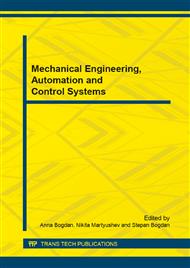[1]
N.V. Martyushev, I.V. Semenkov, Y.N. Petrenko, Impact of protective release coatings with nanopowders on the quality of bronze castings surface, Advanced Materials Res. 872 (2014) 112-117.
DOI: 10.4028/www.scientific.net/amr.872.112
Google Scholar
[2]
N.V. Martyushev, I.V. Semenkov, Y.N. Petrenko, Structure and properties of leaded tin bronze under different crystallization conditions, Advanced Materials Res. 872 (2014) 89-93.
DOI: 10.4028/www.scientific.net/amr.872.89
Google Scholar
[3]
N.V. Martyushev, I.V. Semenkov, Activation of copper and alumina powders in ball mill, Advanced Materials Res. 872 (2014) 137-141.
DOI: 10.4028/www.scientific.net/amr.872.137
Google Scholar
[4]
I.G. Vidayev, N.V. Martyushev, A.S. Ivashutenko, A.M. Bogdan, The resource efficiency assessment technique for the foundry production, Advanced Materials Res. 880 (2014) 141-145.
DOI: 10.4028/www.scientific.net/amr.880.141
Google Scholar
[5]
N.V. Martyushev, I.V. Semenkov, The possibility of casting surface alloying by nanopowders, Advanced Materials Res. 880 (2014) 272-275.
DOI: 10.4028/www.scientific.net/amr.880.272
Google Scholar
[6]
A.V. Kolubaev, E.A. Kolubaev, I.N. Vagin, O.V. Sizova, Sound generation in sliding friction. Technical Physics Letters 31 (10) (2005) 813-816.
DOI: 10.1134/1.2121824
Google Scholar
[7]
E.A. Kolubaev, A.V. Kolubaev, O.V. Sizova, Analysis of acoustic emission during sliding friction of manganese steel, Technical Physics Letters 36 (8) (2010) 762-765.
DOI: 10.1134/s1063785010080250
Google Scholar
[8]
S. Yu. Tarasov, A.V. Kolubaev, Generation of shear bands in subsurface layers of metals in sliding, Physics of the Solid State 50 (5) (2008) 844-847.
DOI: 10.1134/s1063783408050077
Google Scholar
[9]
A.V. Kolubaev, Yu.F. Ivanov, O.V. Sizova, E.A. Kolubaev, E.A. Aleshina, V.E. Gromov, Effect of elastic excitations on the surface structure of hadfield steel under friction, Technical Physics 53 (2) (2008) 204-210.
DOI: 10.1134/s1063784208020096
Google Scholar
[10]
V.M. Pogrebenkov, K.S. Kostikov, Study of phase formation processes in a three-component system of diopside, porcelain, alumina, Advanced Materials Res. 872 (2014) 201-205.
DOI: 10.4028/www.scientific.net/amr.872.201
Google Scholar
[11]
V.M. Pogrebenkov, K.S. Kostikov, Yu.P. Azhel, K.S. Kamyshnaya, Study of Mechanical Activation Processes of Mica Bearing Rocks, Advanced Materials Res. 1040 (2014) 367-371.
DOI: 10.4028/www.scientific.net/amr.1040.367
Google Scholar


